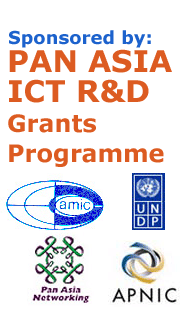
 |  |  |  |
 |
 | ||||||||||||||||||||||||||||||||
|
| ||||||||||||||||||||||||||||||||
 |
|
This tool will clearly have enormous benefits in terms of social development and capacity building in the fields of education. Enhancing the communication corridor between India and Pakistan will decrease the political tension between the two countries and open the door to exchange of development information (in the arena of agriculture in particular) as well as exchange at civil society level, ensuring the strengthening of institutions both sides of the border. In particular the target beneficiaries are civil society organisations such as educational institutions, media organisations and writers groups. Potentially all members of the substantial Panjabi ecommunity will benefit vastly from the Transliterational Tool. Email facilities would cross the geographical divide as well as allow for online chatting. Business could communicate with ease with each other as could media, educational and literary organizations. Existing Gurmukhi sites and basic Shahmukhi sites (using scanned images) could mirror each other. This will also enable the web to be accessed by non-English users and readers in the region. There are also benefits for media, writers, literary and civil society organizations. These target groups are most likely to benefit in the short term from the developments proposed. For media organisations, the software will increase their market. For the literary organisations and writers likewise they will benefit from the development of a wider audience and potential number of participants. The NGOs have already identified the need for the easier production of materials in vernacular language and they will now be able to produce material which will be of wider use. These initial target groups are most liable to participate in the consultation exercise required to develop the software as well as to operationalise the use of the software once it has been developed. It is most crucial that those involved in the development of the software are closely connected to its use. It is for this reason that NGOs, literary organisations and media organisations have been chosen as partners as well as associates to the project. The three main activities of consultation, software development and dissemination will have the greatest chance of success through these target groups. The wider implications are for the development of literacy in both East and West Punjab. Given that in East Panjab there is a wealth of educational materials, from basic to university levels, and in the west a massive population, literate in basic Arabic script (due to being taught the Koran) but has no access to materials. The transliterational tool will help in providing a facility where there can be an instantaneous conversation of materials. Furthermore, given that there is are increasing demands for the making of Panjabi education compulsory in West Panjab, a tool such as one being proposed will be a welcomed breath of fresh air. The project is clearly in line with the overall objective of the programme to in that it will develop a practical solution using existing technologies to provide internet based transliteration for Panjabi. This will increase networking and provide access to ICT for a range of communities. |
